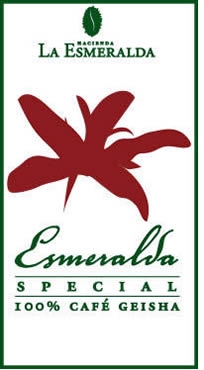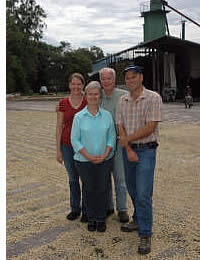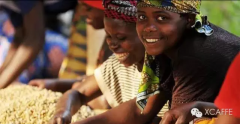Legacy Treasure-- Coffee Culture in Panama
"the Panamanian specialty Geisha is tiresome to drink. Although it originated in Ethiopia, it is like a fish in water in Panama. The Rose Summer of Panama has won many prizes in international competitions. Although it was once underestimated in history, the masterpieces of some small coffee farmers have pushed Panama onto the stage of the world's top producing areas. "
-- Sarah Allen, editor of Barista magazine

According to historical data, coffee was first brought to Panama by European settlers in the 19th century. In the past, Panamanian coffee did not have a good reputation, and its output was only 1 / 10 of that of its neighbor Costa Rica, but now the coffee industry's focus on boutique coffee has made Panama more and more interested in growing coffee.

Panama's geographical advantage is that it has many distinctive microclimate areas suitable for coffee cultivation, and Panama also has many persistent and professional coffee growers. This means there will be a lot of very good coffee in Panama, but these coffees are often associated with high prices.
The high price of coffee in Panama is mainly caused by the following factors:
Land price: for the people of North America, they very much want to buy a stable and beautiful land at a low price. Panama is such a place;
More farmers in Panama grow coffee for export in the name of manors to emphasize their own manors;
Panamanian labor law has higher requirements for labor employment, so the coffee industry has to pay higher wages, which has to be paid by consumers.
Esmeralda Manor
When it comes to coffee prices, we should pay great attention to a manor in Panama, and it can even be said that so far, no other single estate has had such an impact on coffee farming in Central America. This is Esmeralda Manor, which belongs to and is run by the Peterson family.

When the commodity price of coffee was relatively low, the Panamanian Fine Coffee Association organized a competition called "Best Panama": coffee beans from different parts of Panama were ranked and auctioned online. Esmeralda Manor has been growing a kind of coffee called "Geisha" for many years, and the auction has made their coffee known to more people. Then they won the first place in the competition for four consecutive years from 2004 to 2007, and then won the competition again in 2009 and 2013. It kept breaking records until it was priced at $21/lb in 2004 and then rose to $170/lb in 2010. In 2013, a small portion of the sun-treated coffee was sold for $350.25/lb. There is no doubt that this is the highest price ever sold for a single manor coffee.
Unlike some other high-priced coffee (such as cat shit, Blue Mountain), the coffee quality of this estate is really up to its price level, although high demand and market factors also play a role. This record-breaking coffee tastes unusual: bright and strong floral and citrus flavors, full of tea. All these come from the advantage of "Geisha".
This estate has led to the cultivation of "Geisha" in many coffee plantations not only in Panama but also throughout Central America. For many coffee farmers, this variety means a high price, and to a large extent, this perception is correct. Because as a manor that grows "Geisha", the price of its coffee is always higher than that of other estates.
Traceability of origin
Panamanian coffee has high traceability of origin. Generally speaking, the origin of coffee in Panama can be traced to a single manor or even to a field on the manor.
Flavor characteristics
The better coffee in Panama has citrus and floral aromas, bright taste, elegant and complex flavor.
Population: 3406000
2013 production: 6000 tons
The distinction between Panamanian growing areas mainly depends on the sales situation of coffee, but mostly on geographical distribution. In the past, coffee was widely spread, and the following areas are actually one area, but these areas are closely linked.
Boquete
This is the Panamanian region that we are most familiar with. The special mountainous terrain of this area forms a microclimate which is very suitable for growing coffee. Cool weather and frequent fog slow down the ripening process of coffee cherries, and some even say that the climate can already simulate high-altitude planting.
Altitude: 400-1900m
Harvest period: December to March
Planting varieties: Tibica, Kaddura, Kaduai, bourbon, Rosa, San Ramon
Candela volcano
The area produces a lot of food for Panama, as well as excellent coffee. This area borders on Costa Rica.
Altitude: 1200-1600m
Harvest period: December to March
Planting varieties: Tibica, Kaddura, Kaduai, bourbon, Rosa, San Ramon
Renacimiento
Another producing area of Chirqui province, bordering Costa Rica. This producing area is relatively small, so it is not the main producing area of Panamanian boutique coffee.
Altitude: 1100-1500 m
Harvest period: December to March
Planting varieties: Tibica, Kaddura, Kaduai, bourbon, Rosa, San Ramon
The Story of Rosa Coffee
Manor Esmeralda

The scientific name of the tree of Rosa (geisha) is Abyssinia. The first record of these coffee seeds was recorded in 1931 when they were collected in Ethiopia's remote geisha mountain. 1932 they are grown in Kenya, Uganda and Tanzania 1936. Geisha first imported from lyamungu, Tanzania, in Costa Rica in 1953, although several different countries later imported it. It's still debating when and how to get to Panama.
1998 there was some extreme rainfall in the Chiriki area, leaving many coffee farms in the Bockett fungal plague. "Manor Esmeralda" means losing half of the coffee plants. The price Peterson bought on this farm is more than 1996 for coffee and high quality. Only three species of plants survive, one of which is the geisha. It takes five years for coffee trees to reach their full potential, and Peterson decided on the three strongest varieties of plants. Strangely, over the past few decades, plants have also known that as "nationals", restrictions have been placed on many farms in Bockett to protect the rest of the plants from airflow and erosion, mainly due to its height.
Peterson's family and geisha coffee
After Panamanian coffee gained world fame in 2004, Daniel Peterson's Manor Esmeralda discovered that the coffee plant on his coffee plantation was made of a special coffee cup. In January of that year, Daniel began cupping coffee from all parts of the farm, testing him with suspicion. He believes that it may be the farm, coffee is seasoned by the farm production of other strong fine cup production areas, but at the same time diluted by shoddy beans. It turned out that he was right. On the farm there is a small valley with an extreme cup today called "Jaramillo Special".
Other coffee producers in Bockett have begun to grow this special variety of coffee on their own coffee farms. In the years to come, we will know that the excellent quality of this geisha coffee can be replicated or even surpassed. The coffee industry in Panama is just starting to roll.

Important Notice :
前街咖啡 FrontStreet Coffee has moved to new addredd:
FrontStreet Coffee Address: 315,Donghua East Road,GuangZhou
Tel:020 38364473
- Prev

The unique African Dark Horse-- the Coffee Culture of Rwanda
We have never seen such a fast-growing producing area. In eight years, we have gone from a non-coffee producing country to one of the famous producing areas that can host international coffee competitions. This unprecedented growth rate is happening in front of our eyes. Geoff Watts Rwanda, vice president of Intelligentsia Coffee, is located in the southern equator of central Africa. It is a landlocked country with Tanzania to the east.
- Next

The beauty is more mellow than coffee. The origin of classic coffee.
Elegant tea and coffee is a modern and fashionable way of life, through sour, sweet, bitter, astringent taste experience, wash the mind to return to different sensory enjoyment. Each caffeine variety has its own strong or gentle character, such as the masculine Mantenin, which resembles the character of an iron and steel man, and the mellow and fragrant Blue Mountain Coffee, which is the most gentle.
Related
- How did the Salvadoran coffee industry develop in Central America?
- What exactly does the golden cup extraction of coffee mean?
- The Origin of Coffee flower
- [2023 Starbucks World Earth Day] there are more meaningful things besides free Starbucks coffee!
- What kind of coffee is there in Spain? 9 Flavors of Spanish Coffee
- Aromatic African coffee| Kenya's coffee culture and historical production area
- Liberica Coffee Bean knowledge: the characteristics of Liberian Coffee beans of the three original species of Coffee beans
- The origin and formula of Spanish latte introduces the taste characteristics of Bombon coffee in Valencia, Spain.
- How to adjust the solution of over-extracted coffee
- What is the tasting period of coffee beans? What is the period of coffee and beans? How should coffee wake up and raise beans?

